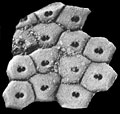The Echinoid Directory
Unibothriocidaris Kier, 1982, p. 310
| Diagnostic Features |
|
|---|---|
| Distribution | Upper Ordovician (Caradoc), North America. |
| Name gender | feminine |
| Type | Unibothriocidaris bromidensis Kier, 1982, p. 311, by original designation. |
| Species Included |
|
| Classification and/or Status |
|
| Remarks |
|



